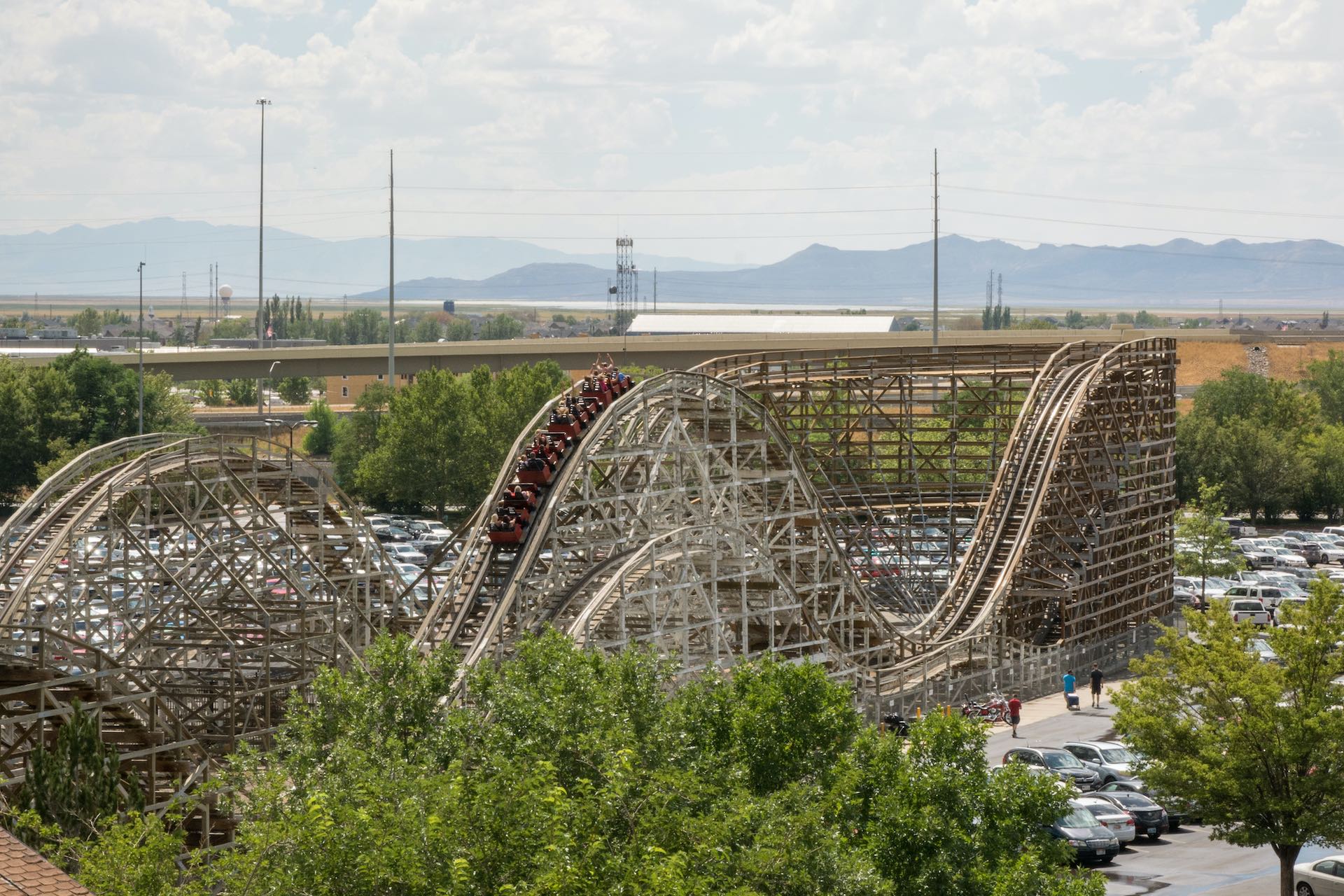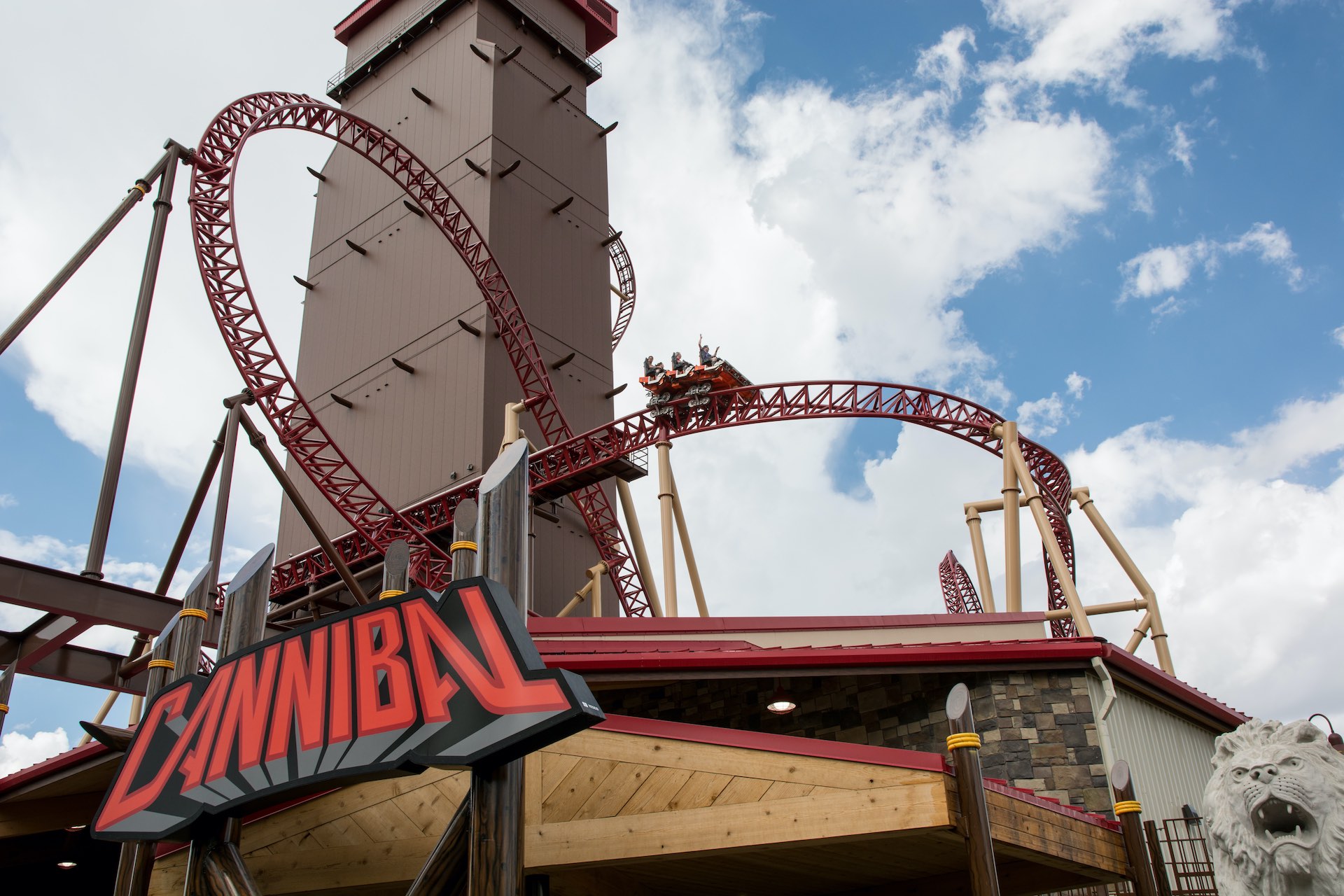ACE 360 Spotlights ACE Roller Coaster Landmarks: Lagoon's Roller Coaster
Monday, April 26, 2021
(1 Comments)
Posted by: Randy Geisler

Photo: Jill Ryan. View full-sized image.
Utah’s Lagoon Celebrates 135 Years of Fun, and Its Roller Coaster Turns 100 Years Young
Even before Utah became a state, one of America’s oldest surviving-to-this-day amusement parks began its life 135 years ago as a resort on the shores of the Great Salt Lake.
In 1886, the Denver & Rio Grande Western Railroad created a bathing resort along the prehistoric lake’s shores. In those days the Great Salt Lake fascinated everyone. The large but strange saline body of water allowed swimmers to not sink, failed to contain
any fish, smelled interestingly and could offer an intriguing spot for folks to cool off and relax saltwaterside under the hot Utah sun. The new resort featured a dance hall, changing rooms and gardens, as well as a train station for the D&RGW. But
the lake level receded dramatically over the following years, leaving the resort high and dry. The decision was made in 1895 to relocate. A major park owner, who happened to also be building the new Salt Lake & Ogden Railroad line, moved most of the
original resort buildings about three miles away to the town of Farmington, about halfway between the burbs of Salt Lake City and Ogdon, conveniently on the way along his new railway line and certain to increase passenger traffic as people headed
to check out the relocated resort. The spot was now named Lagoon because of the small body of water that was dredged for the park during its construction. The park opened with a dance hall, bowling alley, Bowery area, restaurants, live music, picnicking
and boating on the lagoon.
The first amusement attractions installed at Lagoon included a shoot-the-chutes ride and a miniature railroad, and by 1906 the park had purchased an authentic 1893 Herschell-Spillman hand-carved wooden carousel (which survives to this day).

Photo: Jill Ryan. View full-sized image.
Lagoon’s very first coaster arrived in 1907 with Scenic Railway, a 40-foot high 1,500-foot-long double figure-eight layout with side-friction track (guide rails along the sides). This kind of coaster was quite popular worldwide at the time, offering
a gentle “scenic” ride (at 10 cents a pop). It was removed between 1919 and 1921, which might’ve been in order to make way for Lagoon’s next coaster.
For its more thrilling subsequent coaster attraction, Lagoon sought the talents of then-already-famed coaster designer, innovator and multiple patent holder John A. Miller. Miller introduced upstop wheels to coaster tracks and trains in 1919 — wheels
that ran under the track to keep the coaster cars from flying off, thereby locking the trains to the course and allowing for wilder drops, hills and turns. Lagoon had the coaster constructed by Miller and Baker, Inc., a joint venture between Miller
and Harry C. Baker, the latter another legendary coaster builder/designer who would later bring the world-famous Coney Island Cyclone to life.
These two gentlemen created and built for Lagoon a double-out-and-back, 2,500-foot-long, 62-foot-high wooden coaster, famous to this day for its camelback profile showing off multiple hills and dips, an assortment of negative-G moments, exquisite pacing,
fast flat turns and effective double-dip finale.

Photo: Jill Ryan. View full-sized image.
The ride has seen no official lasting name other than "Roller Coaster," but it has also been called the White Roller Coaster, unofficially nicknamed that by the locals, because the structure was painted and repainted white. In the olden days, before
pressure-treated wood was used, painting a coaster was effective in protecting the wood, and white was the cheapest color. But in modern times that’s no longer necessary, so Lagoon stopped painting its woodie white in the early 2000s as more and more
trackage was replaced over the years with treated wood. The coaster is now increasingly boasting its natural woodish brown.
Roller Coaster has enjoyed many other names briefly tried over the decades. It originally opened as the Pippin Dips back in 1921 and has since changed names a few times as the Lagoon Dips, Giant Coaster and Silver Coaster.
The coaster has run with trains provided by the famed Philadelphia Toboggan Company through most of its life, although in 2018 the park brought in new trains provided by Great Coasters International Inc., with the firm’s Millennium Flyer-style carriages
making up the ride’s brand-new rolling stock.
This signature coaster attraction has proved to be very successful for Lagoon and has remained very popular, now for 100 years.
Roller Coaster has gained historic importance, as one of only eight Miller coasters left operating (out of the 150 he designed). And the ride is now the seventh oldest roller coaster operating in the world (the fourth oldest in North America).
In 2005, it was recognized as an American Coaster Enthusiasts (ACE) Roller Coaster Landmark, a designation reserved for rides of historical significance. Lagoon placed the ACE Coaster Landmark Plaque for
display within the Roller Coaster station house.

Photo: Jill Ryan. View full-sized image.
Roller Coaster is significant to the animal kingdom as well. Sheep grazed on the grass under the coaster's structure until around 2000. For a while, a family of racoons lived inside the station. On May 17, 1968, the Monkees (the popular pop-rock
group and TV stars in the late 1960s), who were in the area for concerts (including at Lagoon’s former Patio Gardens), famously visited the park to have a bit of fun, and with hordes of fans thrilled at seeing them, they even rode Roller Coaster.
In fact, Lagoon has been the place for many performers over the past years, such as Louis Armstrong, Duke Ellington, the Everly Brothers, the Beach Boys (who made mention of the park in the song "Salt Lake City" on their 1965 album “Summer Days and
Summer Nights!!”), the Doors, Frankie Avalon, the Rolling Stones, Johnny Cash, Jimi Hendrix and many, many more.
The wooden coaster is one of three rides at Lagoon that are on the National Register of Historic Places — the other two being the Flying Aces (a spinning flying scooter ride made by Bisch-Rocco Amusement Company in 1941) and the Herschell-Spillman carousel.
Lagoon has always paid attention and regard to history. In 1976 Lagoon purchased Pioneer Village, a collection of authentic Utah pioneer buildings and artifacts, including several historic structures that had been privately collected and exhibited
in the Salt Lake City area since 1953. The buildings were moved to Lagoon, and the 2-foot narrow-gauge "Pioneer Village Railroad" (featuring "Old Ironsides," a Crown Metal Products locomotive) circled the village section at Lagoon — all offering park
visitors a living museum of Utah’s pioneer past.
In November 1953, Roller Coaster and Lagoon survived a huge devastating fire. The blaze damaged much of the park, including the fun house, dance pavilion and front portion of the roller coaster. While the park was ablaze, then-owner Robert Freed
sprayed the carousel with water to protect its hand-carved figures. But Lagoon was quickly rebuilt in order to open it for the next season. Many rides were restored or replaced, and a few new rides were added too, helping to refresh the park and allowing
it to move forward renewed and invigorated as well.

Photo: Jill Ryan. View full-sized image.

Photo: Jill Ryan. View full-sized image.
In fact, Lagoon has added multiple rides and attractions over its many decades. As a major example, in 1989 Lagoon made way for a $5.5 million Lagoon-A-Beach water park (taking the place of the large and once-popular swimming pool at the park, which had
been closed years earlier), although its construction spelled the end of the small-scale railroad operations in Pioneer Village, as some of the supports stood in the way of the track.
Since the debut of Roller Coaster in 1921, the park has added 13 more roller coasters, including three Wild Mice (in 1965, 1971 and 1998, the last of which stands to this day); two steel coasters made by famed German designer Anton Schwarzkopf
(added in 1976 with Jet Star 2, and then in 1983 with Colossus the Fire Dragon double looper); Wicked in 2007 (a Zierer tower launching steel coaster); and Cannibal in 2015, a multi-inversion steel thriller designed and
built in house. Lagoon management (the still-traditional park is family owned and operated to this day) has played a role in the concept and design of its recent rides, making the attractions unique and thematically strong, while offering an aesthetic
flair with an experience special and particular to Lagoon.

Photo: Jill Ryan. View full-sized image.
And Lagoon has another coaster in the works, tentatively named Primordial. The massive mountainous steel ride is slated to open in 2021 (or 2022 perhaps), thus ensuring Lagoon’s commitment to its continuing contemporary success and vitality. The
park offers great attractions and wonderful rides, both very new and also still very vintage (with its many classic, time-honored rides still operating), as it acknowledges its glorious past, celebrating 135 years of bringing fun to its many fans.
And doing so on the coaster front as well, as it looks forward to its newest, soon-to-be-opened thriller while also honoring 10 decades of historical excitement on its 100-years-young landmark wooden Roller Coaster.
And all still near the shores of the Great Salt Lake.
— Randy Geisler
Special memories from our members:

Photo: Jill Ryan. View full-sized image.
This Lagoon story starts in Gothenburg, Sweden. I was attending the ACE Scandinavia trip in 2011 (my first ACE international trip), and on the morning of our visit to Liseberg, I was waiting to ride Lisebergbanan when a friendly ACE member I hadn't previously
met asked if we could ride together. I said "sure!" He introduced himself as Jeff Voogt, and we had a great time riding Lisebergbanan together. Ever since, whenever we run into each other at an amusement park, whether in the U.S. or on another ACE
international trip, we try to ride a coaster together. During the ACE Preservation Conference at Lagoon in 2016, Jeff approached me and suggested we ride Spider together. I told him of course, but I didn't like to spin. (Of course I had to
ride it to get the credit, though, so on it we went!) Well, I've never experienced so much spinning on any coaster (or probably any other amusement ride) in my life! When we got off, other ACErs said they couldn't believe how much we were spinning.
I was dizzy, and Jeff and I were both laughing, but I told him that maybe we should avoid riding spinning coasters together from now on. We haven't since. But Jeff, I'll ride any other type of coaster with you any time!
— Vanessa Thomas, Tucson,
Arizona

Photo: Jill Ryan. View full-sized image.
American Coaster Enthusiasts is a nonprofit, volunteer organization dedicated to the preservation, promotion, appreciation and safe enjoyment of roller coasters. With 6,000 members worldwide, ACE is the largest and longest-running enthusiast organization
in the world. Members of ACE receive exclusive park benefits, newsletters, magazines and the opportunity to attend national, local and even international tours at parks. You can enjoy the benefits of members today! Join at join.aceonline.org.
|